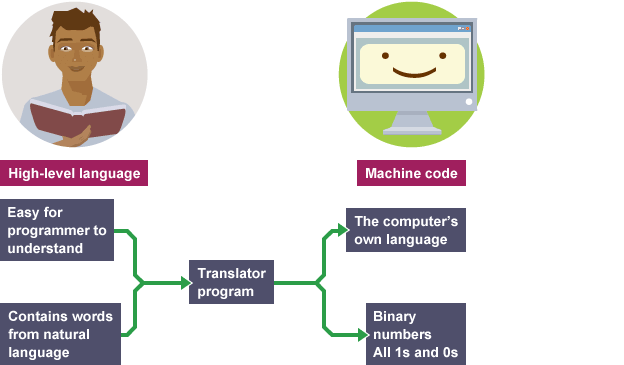Unleashing The Power Of Programming: An Introduction To Coding
Computer coding or programming for beginners utilizes high-level computer programming languages, such as Python, JavaScript, Visual Basic, and C++. This is in contrast to machine level programming which is much more complex. High-level programming languages are a lot easier to learn and understand.
High-level computer programming languages have similar syntax, semantics, and terms as natural languages. For example, statements that contain the English words 'print', ‘if’, 'input', and 'while' are common in Python programming statements.
Machine level languages use machine-specific syntaxes, codes, and binary numbers. This illustration shows the difference between high-level languages and machine code.
 (Image source: https://www.bbc.co.uk/bitesize/guides/z4cck2p/revision/)
(Image source: https://www.bbc.co.uk/bitesize/guides/z4cck2p/revision/)
What is coding?
Coding or computer programming involves creating step-by-step instructions that have a logical structure. Inputting these instructions means a computer can execute a program, or a compiled set of programs, called software applications.
When you write a computer program using a high-level language like Python, you are instructing a computer what to do for a specific purpose. This instruction is then translated into machine codes and binary bits of information by the computer. Although you can use ready-made and user-friendly applications to do certain tasks, there are many cases when you’ll need to customize your programs or software applications, or even develop your own.
Computer coding can be classified into four major types:
- Imperative or procedural (examples: Cobol, Fortran, C)
- Functional (examples: Haskell, Scala, Clojure)
- Logical (examples: Prolog, SQL)
- Object-oriented (examples: Java, C++, Python)
Many high-level programming languages use logic and functions to define instructions.
Why is coding becoming popular?
The demand for coding skills, even at a basic level, is crucial in our technologically-dependent world. From mobile phone games to complicated stock market transactions and building security systems to A.I.-aided military defense systems, computer programmers are in demand.
For example, global trade and financial transactions as we know them today would collapse without the expert work of computer programmers. That makes the number one driving force for the popularity of coding the global economic demand for the job. Private corporations, banks, and the military need computer programmers. With the rise of A.I., this need is likely to double in the next few years.
Elementary and secondary schools are now offering subjects in coding as part of the curriculum. Computer programming skills are a necessity if you want to pursue a high-paying career that involves science and technology. Even philosophy graduates are now learning computer programming!
How do I start learning to code?
You can easily learn how to code at any time. Basic coding can even be taught to preschoolers. It’s best to start at a young age, especially as an elementary school student, when you can make coding your natural second language. Computer coding is very similar to written language, but uses simpler and more structured syntaxes or “grammar”.
There are a lot of online courses that offer coding, and some are even free. If you don’t know any high-level computer programming languages, it’s best to start with learning how to write algorithms. These are not programming languages per se, but they do define the flow and structure of programs that you want to create. Algorithms serve as a guide once you start programming. Start with easy programming languages, such as Python, if you’re a beginner.
You can practice programming based on existing computer programs. See if you can understand and follow the line-by-line instructions. You can also practice debugging a program by looking at the wrong codes and wrong syntaxes. It’s really a trial-and-error process and all about learning from mistakes and coding errors before you become highly proficient in programming.
What are the benefits of learning code?
Learning to code can improve your logical skills, and it also widens your career opportunities. Whatever career goal you have, even if it is remotely related to computer science, knowledge and skills in coding will go a long way.
It gives you the competitive edge in solving many work-related problems. For example, if you want to pursue a career in marine biology, you can use your coding skills to design a program or software to track schools of fish.
Another benefit of learning code is that you’ll be less vulnerable to online and technology-related scams and other types of cybercrime. You may not be totally immune, but you are less likely to become a victim.
Knowledge in coding will allow you to save on specific software applications that you need. You can either improve on open source software or create your own software applications. You can customize your existing open source software.
Coding terminology for beginners
Just like in other disciplines, computer programming or coding also has its own jargon. It’s important that you understand the basic terminology in coding in order to learn how to code. Here are some common examples of coding terminology that you need to know if you are a beginner.
1. Algorithm
An algorithm is a set of rigorous, step-by-step instructions that a human or a machine can follow. It can be written in the form of flowchart that is easily readable by humans who want to create a program. An algorithm is designed to solve a problem or complete a task.
2. Syntax
Syntax is equivalent to grammar in natural language. Computer syntax is a highly structured set of codes that mean something to a computer. Each programming language may have different types of syntax.
3. Data structure
Computers store data in organized and oftentimes multi-level systems. Data structure refers to the specific format for storing, processing, and retrieving data. A data can be pure texts, graphics, videos, or programs. Data structure makes it easier for programmers to access and work with data.
4. Application programming interface
An application programming interface, or API, is a software application that serves as an intermediary between two different applications so they can interact and translate data into useful information. Many APIs are used online, such as the following examples:
- Twitter bots
- Paying with PayPal
- Google Maps
- E-commerce functions
5. Integrated development environment
Programmers sometimes need an integrated development environment, or IDE. An IDE is a type of program that provides comprehensive tools for programmers to use in software development. It typically includes a source code editor, build automation tools, and a debugger.
At Arduino, we have our own IDE that contains a text editor for writing code, a message area, a text console, a toolbar with buttons for common functions and a series of menus.
What types of jobs use coding?
A wide range of career opportunities is open to those who are proficient in coding or computer programming. These include freelance, contract, and ‘regular’ jobs.
Although virtually all types of jobs that involve a computer system or a computerized data collection device will need code servicing at some point, only some jobs require actual coding skills. Here are some of the top examples:
- Data scientist
- Software engineer
- Computer systems analyst
- Computer and iInformation systems manager
- Network administrator
Summary
Knowledge and skills in coding or computer programming is now more necessary than ever before. The global economy needs a job market that has proficient coders at various levels. You can learn coding at any school or career level, and use it to support your career advancement.
Are you an educator looking for coding resources for middle school, high school or university? Take a look at Arduino Education kits and how they can support your hands-on coding and programming lessons.
